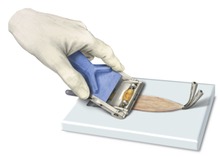Coriotome
A coriotome (from Latin corium dermis and old Gr. Τομή tomé incision) is a surgical cutting instrument for the rapid preparation of skin grafts of even thickness . It belongs to the group of dermatomes .
use
The coriotome can be used to prepare a full-thickness or split-thickness skin graft. When preparing a full-thickness skin graft, it replaces the time-consuming removal of fat tissue with scissors . Small and medium-sized split-thickness skin grafts can be produced from a full-thickness skin graft with the coriotome. No secondary wound healing has to take place at the removal site, as the removal defect can be closed with a suture.
functionality
For the removal of the skin layers, the skin graft is held under tension in the removal direction. That came with a special board with a clamping device or with vascular clamps ( mosquito clamps ). The tissue is removed in layers by pulling the coriotome over the transplant. The ends of the two legs of the coriotome serve as spacers and are shaped in such a way that the depth of removal can be continuously regulated by the inclination of the coriotome to the base.
swell
- Dermatologic Surgery . 2004 May; 30 (5): 787-90. The coriotome - a new hand-held device for trimming of skin grafts.
- https://www.haut-mz.de/heilende-medizin/koriotom/
- Erich Landes, Maurizio Podda, Roland Kaufmann: Dermatological operations - color atlas and textbook of skin surgery . 4th edition. Thieme, ISBN 978-3-13-156924-0 , pp. 19 . limited preview in Google Book search

